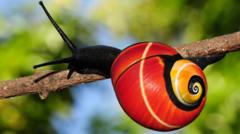Researchers have initiated a collaborative mission to save the incredibly beautiful Polymita tree snails, native to Eastern Cuba, which are rapidly vanishing from their natural environments. Renowned for their strikingly colorful and intricately patterned shells, these snails are unfortunately prized by collectors, leading to disastrous consequences for their population.
Polymita snails encompass six recognized species, with Polymita sulphurosa being the most critically endangered. Its shells are characterized by vibrant green hues adorned with blue flames and bright orange and yellow stripes. The evolutionary mystery surrounding the snails’ eye-catching coloration has drawn the attention of scientists, including evolutionary geneticist Prof Angus Davison from the University of Nottingham. Prof Davison acknowledges the paradox that the very quality that fascinates scientists is simultaneously jeopardizing the snails’ survival.
Databases have revealed numerous online listings in the UK selling Polymita shells, underscoring the demand that drives exploitation in their native Cuba. Despite international regulations prohibiting the export of these snails without permits, legal sale of shells outside Cuba persists, raising concerns over the impact of shell collecting on already vulnerable populations.
In light of these threats, Prof Davison is collaborating with conservation biologist Prof Bernardo Reyes-Tur from Santiago de Cuba. The partnership combines efforts to understand the snails' evolutionary biology with practical approaches to breeding and conserving the species in captivity. Prof Reyes-Tur has taken on the challenge of breeding these snails at his home in a climate with unreliable power supplies, which complicates husbandry efforts.
Meanwhile, advanced genetic research is underway at the University of Nottingham, where samples of snail tissue are preserved for genome analysis. This research aims to determine species relationships and the genetic basis for their unique coloration, which could be essential for conservation strategies as their habitats face ongoing threats from climate change and deforestation.
As Eastern Cuba remains the only natural habitat for these snails, local expertise is paramount. Conservationists hope that by leveraging both local knowledge and scientific research, meaningful strides can be made to protect the Polymita snails from slipping into oblivion as their striking beauty increasingly becomes a target for collectors worldwide.





















